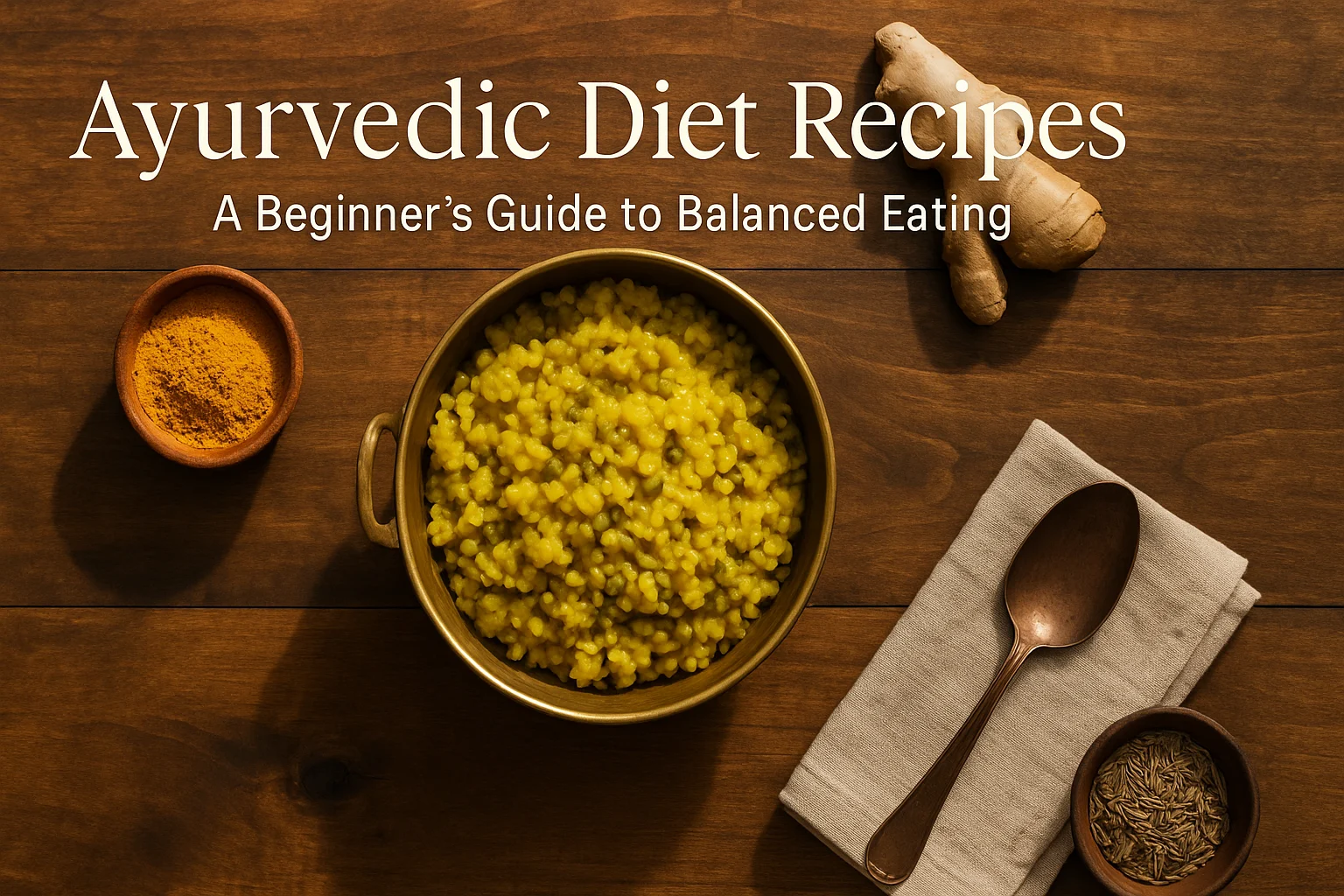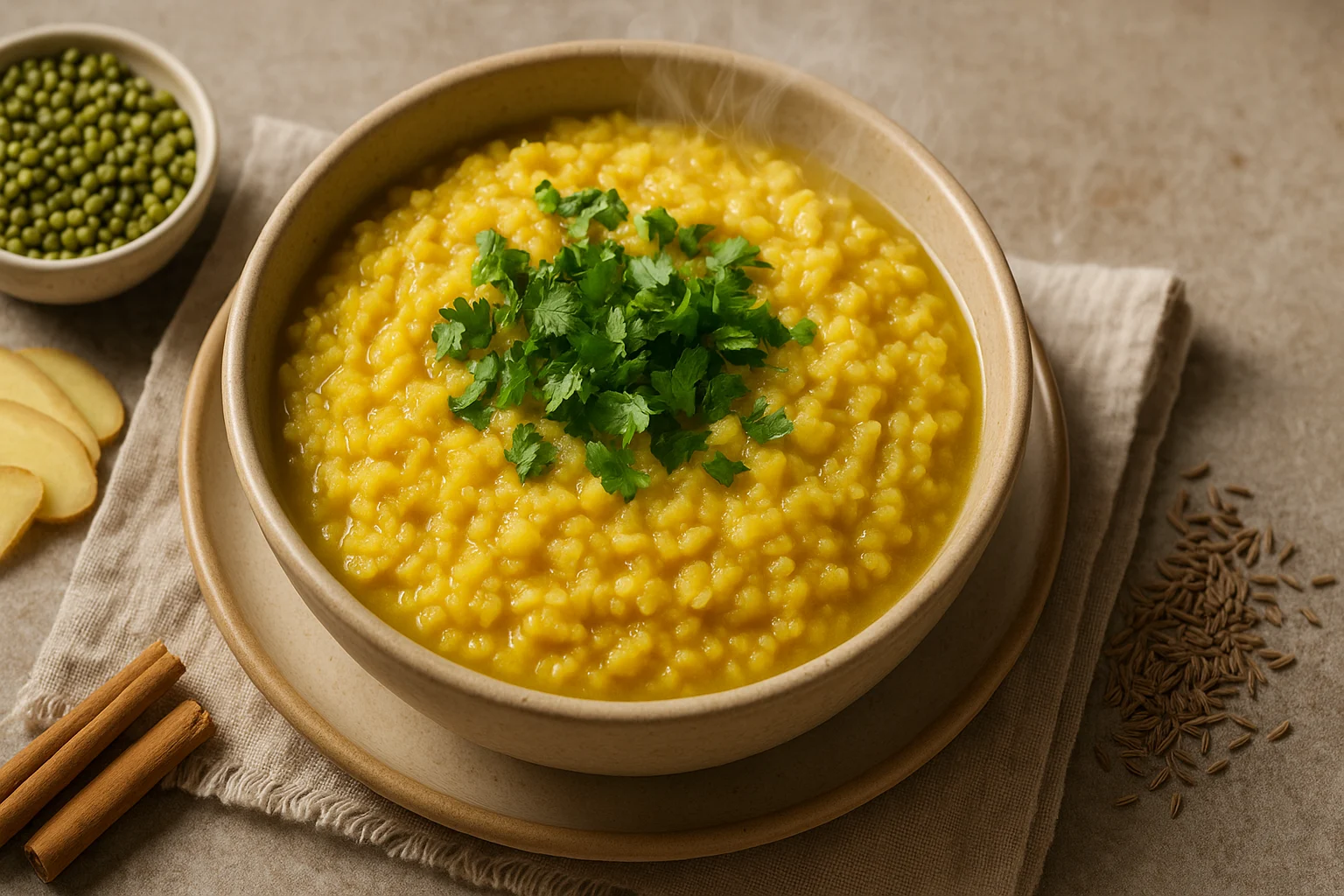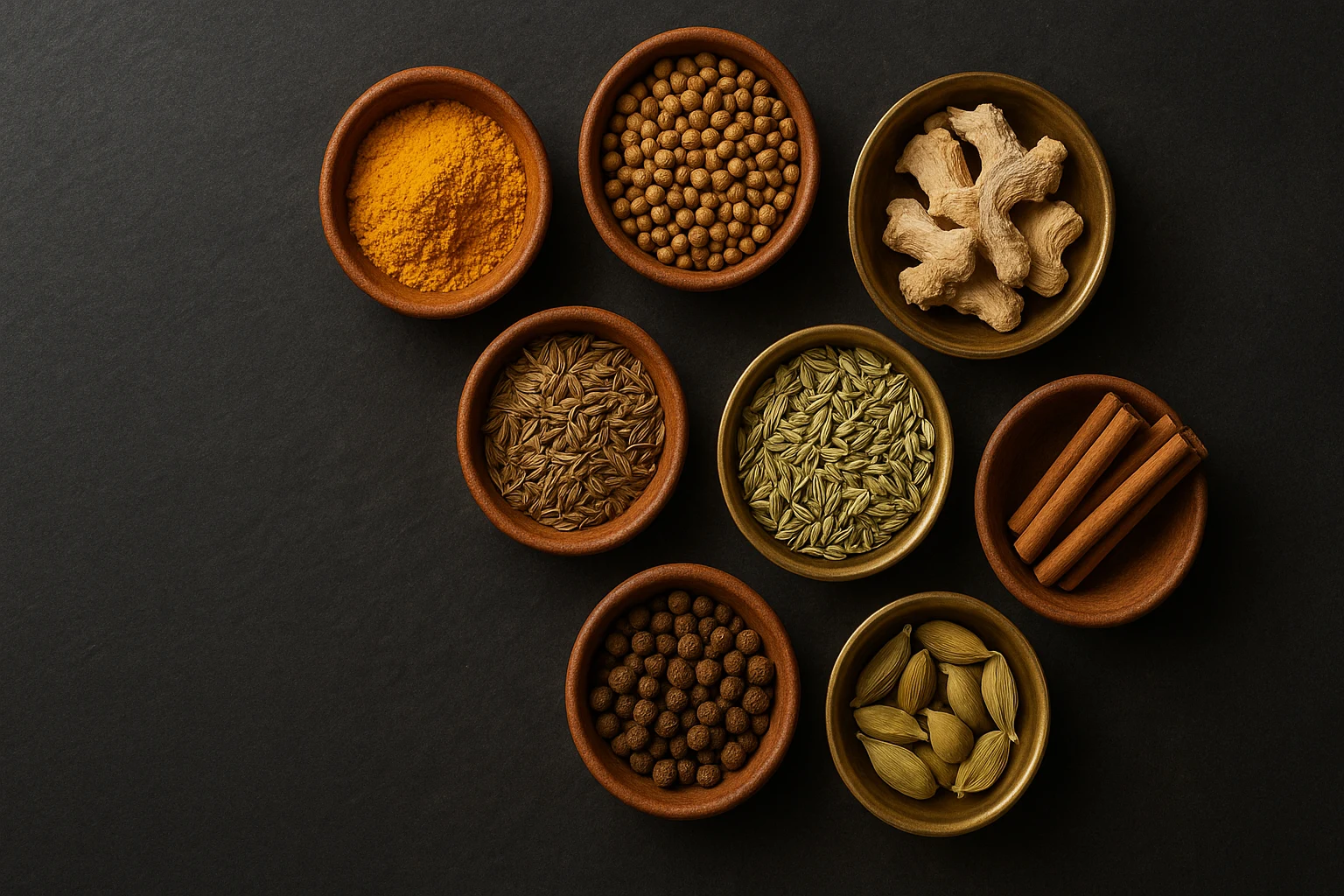
Feeling bloated or drained? Let Ayurveda light the way. Ayurvedic diet recipes, rooted in simple, nourishing meals, help you reconnect with your body’s natural rhythms. This beginner-friendly guide explores essential principles, Dosha-balancing foods, and easy Ayurvedic meal ideas to support vibrant digestion and lasting wellness. Want to go deeper than diet? Explore how daily routines and healing practices come together in our full ayurvedic wellness guide.
Find Your Perfect Recipe!Table of Contents
- Key Takeaways for These Recipes
- Core Principles for These Recipes
- The Six Tastes for Balanced Nutrition
- Ayurvedic Food Principles for Better Digestion
- Seasonal Eating in Ayurveda
- Understanding Your Dosha for Personalized Eating
- Balanced Meal Ideas for Daily Wellness
- My Story with Ayurveda Cooking
- Beginner-Friendly Recipes to Try
- Dosha-Friendly Recipe Finder
- FAQs About These Meals
- Conclusion: Begin Your Ayurvedic Journey
Key Takeaways for Ayurvedic Diet Recipes
- Personalized Eating: Ayurveda identifies three body-mind types, or Doshas (Vata, Pitta, Kapha), encouraging foods that balance your unique Dosha for optimal health.
- Digestive Power: Agni, your digestive fire, is central to health in Ayurveda. Supporting it may help comfortable digestion and overall vitality.
- Six Tastes: Including sweet, sour, salty, pungent, bitter, and astringent tastes in meals promotes balance and reduces cravings.
- Mindful Rituals: Eating in a calm environment, at regular times, and chewing thoroughly enhances digestion.
- Supportive Recipes: Ayurvedic diet recipes use fresh, seasonal ingredients and warming spices for easy, delicious meals that may support comfortable digestion.
This post has affiliate links. We may earn a commission. Learn more.
Core Principles for Ayurvedic Diet Recipes
Understanding the Three Doshas
At its core, Ayurveda, meaning “the science of life,” is a holistic lifestyle that emphasizes balance. Specifically, the three Doshas—Vata, Pitta, and Kapha—are combinations of the five elements (ether, air, fire, water, earth) that shape your physical and mental traits. To understand the basics of this approach, explore our guide on Ayurvedic diet fundamentals. For example, everyone has all three Doshas, but one or two dominate, forming your unique constitution (Prakriti). Here’s a quick overview:
- Vata (Air + Ether): Governs movement and creativity. Vata types are light, enthusiastic, but may face anxiety, dry skin, or irregular digestion when imbalanced.
- Pitta (Fire + Water): Manages metabolism and transformation. Pitta individuals are ambitious but may experience inflammation or irritability if out of balance.
- Kapha (Water + Earth): Supports structure and stability. Kapha types are calm but may struggle with sluggishness or congestion when imbalanced.
Importantly, the goal of a balanced Ayurvedic meal is to choose foods that support your unique Dosha and address any imbalances. For deeper insights, consider exploring resources from Banyan Botanicals.
Agni: Your Digestive Fire
In Ayurveda, strong digestion, or Agni, is considered the cornerstone of health. Think of Agni as a cozy campfire supporting digestion. When it’s well-tended, many people notice steadier energy and a clearer mind; when it’s low, things like bloating or sluggishness can pop up. Many healthy Ayurvedic meals are crafted to kindle this fire so your meals truly nourish you.
“When Agni is healthy, digestion is healthy. When digestion is healthy, the body is healthy.” — Ayurvedic Proverb
The Six Tastes for Balanced Nutrition
Ayurveda teaches that a meal is like a symphony of flavors, with six tastes (Rasa) that nourish both body and mind. By including all six—sweet, sour, salty, pungent, bitter, and astringent—you create satisfying, balanced meals. Here’s how each taste impacts your Doshas:
- Sweet (Madhura): Grains, milk, fruits, root vegetables. Cooling and grounding, it balances Vata and Pitta but may increase Kapha.
- Sour (Amla): Citrus, yogurt, fermented foods. Warming and cleansing, it balances Vata but can aggravate Pitta and Kapha.
- Salty (Lavana): Sea salt, sea vegetables. Hydrating and warming, it balances Vata but may increase Pitta and Kapha.
- Pungent (Katu): Chili, ginger, garlic. Stimulating and warming, it balances Kapha but can increase Vata and Pitta.
- Bitter (Tikta): Leafy greens, turmeric. Cooling and traditionally considered cleansing, it may help balance Pitta and Kapha but can increase Vata for some.
- Astringent (Kashaya): Legumes, raw vegetables, pomegranates. Toning and cooling, it balances Pitta and Kapha but may increase Vata.
For instance, a balanced plate might include rice (sweet), lemon (sour), a pinch of salt, ginger (pungent), spinach (bitter), and lentils (astringent). These seasonal meals from the Ayurveda food guide help your body adapt to environmental changes.

Ayurvedic Food Principles for Better Digestion
Smart Food Combining
Certain food pairings can feel heavy for Agni. To avoid this, consider these guidelines:
- Eat fruits alone, as they digest quickly and may ferment with other foods.
- Ayurvedic guidance suggests avoiding milk with sour or salty foods; some people find these combinations heavy.
- Traditionally avoid pairing milk with meat or fish in Ayurveda.
- Some practitioners advise skipping very hot drinks with very cold foods to keep digestion comfortable.
- Ayurvedic texts advise not to heat honey; add it after cooking or once dishes are off heat.
- Consider limiting nightshades (tomatoes, peppers) if you’re heat-sensitive (Pitta), adjusting to personal tolerance.
- Pair legumes with grains, like rice and mung dal in Kitchari, for easy digestion.
Mindful Mealtime Practices
Besides what you eat, how you eat matters significantly. For example, eating in a calm environment enhances digestion, much like practicing yoga and breathwork for stress relief supports mental clarity. Follow these tips:
- Eat in a calm, distraction-free environment.
- Stick to regular meal times, with lunch around noon when Agni peaks.
- Eat only when hungry, listening to your body.
- Stop at ¾ full to leave room for digestion.
- Chew thoroughly, as digestion starts in the mouth.
- Sip warm water during meals, avoiding large amounts.
- Rest for 5-10 minutes after eating to aid digestion.
- Keep dinner light and eat 2-3 hours before bed.
Ghee and Spices: The Heart of Ayurvedic Cooking
Ghee, or clarified butter, is Ayurveda’s “liquid gold.” With a high smoke point, it’s ideal for cooking and is said in Ayurveda to carry the qualities of spices; in practical cooking, it helps disperse fat-soluble flavors and aromas. Meanwhile, spices like ginger, turmeric, cumin, and fennel may support comfortable digestion and reduce gas for some.

Seasonal Eating in Ayurveda
Ayurveda emphasizes eating with the seasons to stay in harmony with nature. For example, in winter (Vata season), I favor warm, grounding foods like stews and root vegetables. In summer (Pitta season), I opt for cooling foods like cucumbers and melons. In spring (Kapha season), I choose light, pungent foods like leafy greens and ginger. These Ayurvedic diet recipes adapt to your environment. To align your meals with daily rhythms, explore our Ayurvedic daily routine guide.
Understanding Your Dosha for Personalized Eating
While a professional consultation pinpoints your Dosha, this table offers a starting point:
| Dosha | Characteristics (Balanced) | Common Imbalances | Food Guidelines |
|---|---|---|---|
| Vata | Creative, quick, slender | Anxiety, dry skin, constipation | Warm, moist, sweet, sour, salty |
| Pitta | Intelligent, ambitious, sharp | Acidity, inflammation, irritability | Cooling, sweet, bitter, astringent |
| Kapha | Calm, grounded, sturdy | Sluggishness, weight gain, congestion | Light, dry, pungent, bitter, astringent |
Disclaimer: Consult an Ayurvedic practitioner for personalized guidance, especially for mixed Dosha types like Vata-Pitta, which may need tailored meals. For a detailed Ayurveda food guide, refer to our companion Dosha breakdown with food recommendations.
Balanced Ayurvedic Meal Ideas for Daily Wellness
Now, let’s dive into delicious Ayurvedic meal ideas! These beginner-friendly meals use fresh, seasonal ingredients, prepared with intention to nourish body and soul.
Ayurveda Food Guide: Kitchen Staples
- Grains: Basmati rice, quinoa, oats, millet, barley.
- Legumes: Mung dal, red lentils, chickpeas.
- Vegetables: Seasonal root vegetables, leafy greens, squash.
- Fruits: Ripe, seasonal fruits.
- Fats: Ghee, olive oil, coconut oil.
- Nuts & Seeds: Soaked almonds, walnuts, pumpkin seeds.
- Dairy: Organic milk (warmed), homemade yogurt.
- Spices: Turmeric, cumin, coriander, ginger, cardamom.
- Sweeteners: Dates, maple syrup, jaggery.
Sample Meal Plans by Dosha
Here’s how to tailor meals for each Dosha, keeping your unique needs in mind:
- Vata: Warm, grounding foods like spiced oatmeal or Kitchari with root vegetables. Focus on sweet, sour, salty tastes.
- Pitta: Cooling, soothing meals like quinoa salad or rice pudding with cardamom. Emphasize sweet, bitter, astringent tastes.
- Kapha: Light, stimulating dishes like lentil soup or vegetable stir-fry with pungent spices. Prioritize pungent, bitter, astringent tastes.
Easy Ayurvedic Diet Recipes to Try
Warming Spiced Oatmeal (Vata & Kapha Balancing)
A cozy, grounding breakfast to start your day with warmth.
Yield: 1 serving | Prep Time: PT2M | Cook Time: PT7M
Ingredients
- ½ cup rolled oats
- 1 cup water or unsweetened plant milk
- Pinch of cinnamon
- Pinch of cardamom
- Small piece of fresh ginger, grated (optional, for Kapha)
- 1 tsp ghee (for Vata)
- Optional toppings: soaked almonds, chopped dates, diced apple (cooked)
Instructions
- Combine oats, water/milk, cinnamon, cardamom, and ginger in a saucepan.
- Bring to a boil, then simmer for 5-7 minutes, stirring occasionally.
- Stir in ghee, if using.
- Top with almonds, dates, or apple. Serve warm.
Cooling Cardamom Rice Pudding (Pitta Balancing)
A soothing, creamy breakfast to cool Pitta’s fire.
Yield: 1 serving | Prep Time: PT5M | Cook Time: PT25M
Ingredients
- ¼ cup basmati rice, rinsed
- 1.5 cups water or organic milk
- 2-3 green cardamom pods or ¼ tsp ground cardamom
- 1 tsp maple syrup or jaggery (optional)
- Pinch of saffron (optional)
- Few drops of rosewater (optional)
Instructions
- Combine rice, water/milk, and cardamom in a saucepan.
- Boil, then simmer for 20-25 minutes, stirring occasionally.
- Remove from heat, add sweetener, saffron, and rosewater.
- Serve warm or slightly cooled.
Classic Kitchari (Tri-Dosha Balancing)
A soul-warming, traditionally cleansing staple in Ayurvedic cooking.
Yield: 4 servings | Prep Time: PT10M | Cook Time: PT40M
Ingredients
- 1 cup yellow split mung dal, soaked and rinsed
- ½ cup basmati rice, rinsed
- 6 cups water
- 2 tbsp ghee
- 1 tsp cumin seeds
- ½ tsp black mustard seeds (optional)
- ½ tsp turmeric powder
- 1 tsp grated fresh ginger
- ¼ tsp asafoetida (hing)
- ½ tsp ground coriander
- ½ tsp ground fennel
- 2 cups chopped seasonal vegetables
- Salt to taste
- Fresh cilantro for garnish
Instructions
- Heat ghee in a pot, add cumin and mustard seeds, and sauté until they pop.
- Add ginger, turmeric, hing, coriander, and fennel. Sauté for 30 seconds.
- Add mung dal and rice, stir to coat with spices.
- Add water, boil, then simmer for 15-20 minutes.
- Add vegetables, simmer for 15-20 minutes more, adding water if needed.
- Season with salt, garnish with cilantro, and serve hot.
Spiced Vegetable & Lentil Soup (Kapha & Vata Balancing)
A light, warming soup to energize Kapha and soothe Vata.
Yield: 4 servings | Prep Time: PT15M | Cook Time: PT40M
Ingredients
- 1 tbsp ghee or olive oil
- 1 tsp cumin seeds
- ½ tsp black mustard seeds
- ½ tsp turmeric powder
- ¼ tsp cayenne pepper (optional, for Kapha)
- 1 inch fresh ginger, grated
- 1 cup red lentils, rinsed
- 6 cups vegetable broth or water
- 3 cups chopped mixed vegetables
- Salt and black pepper to taste
- Fresh cilantro for garnish
Instructions
- Heat ghee/oil, add cumin and mustard seeds, and sauté until fragrant.
- Add turmeric, cayenne, and ginger. Sauté for 30 seconds.
- Add lentils, broth, and vegetables. Bring to a boil.
- Simmer for 25-30 minutes until tender.
- Season with salt and pepper, garnish with cilantro, and serve hot.
Mung Bean & Vegetable Stir-Fry (Kapha & Pitta Balancing)
A light, flavorful dinner for easy digestion.
Yield: 2 servings | Prep Time: PT15M | Cook Time: PT25M
Ingredients
- 1 cup whole green mung beans, soaked overnight
- 1 tbsp coconut oil or ghee
- 1 tsp black mustard seeds
- 1 tsp cumin seeds
- Pinch of asafoetida (hing)
- 1 inch fresh ginger, minced
- 2 cups chopped vegetables (broccoli, bell peppers)
- ½ tsp turmeric powder
- ¼ tsp black pepper
- Salt to taste
- Fresh cilantro for garnish
- Optional: squeeze of lime juice
Instructions
- Cook mung beans in 3 cups water for 15-20 minutes. Drain.
- Heat oil/ghee, add mustard and cumin seeds, and let them pop.
- Add hing and ginger, sauté for 30 seconds.
- Add vegetables, stir-fry for 5-7 minutes.
- Add mung beans, turmeric, pepper, and salt. Toss to heat through.
- Garnish with cilantro and lime juice. Serve warm.
Quinoa Salad with Fresh Herbs (Pitta & Kapha Balancing)
A refreshing, light dinner for Pitta and Kapha.
Yield: 2 servings | Prep Time: PT15M | Cook Time: PT15M
Ingredients
- 1 cup quinoa, rinsed
- 2 cups water
- ½ cucumber, diced
- ½ cup cherry tomatoes, halved
- ¼ cup fresh mint, chopped
- ¼ cup fresh cilantro, chopped
- 2 tbsp roasted pumpkin seeds (optional)
- 1 tbsp olive oil
- Juice of ½ lemon
- Salt and black pepper to taste
Instructions
- Cook quinoa in water for 15 minutes. Fluff and cool slightly.
- Combine quinoa, cucumber, tomatoes, mint, and cilantro in a bowl.
- Whisk oil, lemon juice, salt, and pepper for dressing.
- Toss dressing with quinoa mix. Add seeds if using. Serve at room temperature.
Personal Story: My Journey with Ayurveda Cooking
A few years ago, I struggled with constant bloating and low energy. Traditional diets didn’t help, but then I discovered Ayurveda. For example, making Classic Kitchari for a week felt like a gentle reset for my digestion, leaving me lighter and more energized. Consequently, these meal ideas became my go-to for feeling balanced and vibrant.
Find Your Dosha-Friendly Ayurvedic Diet Recipe
Find Your Dosha-Friendly Meal
Pick your dosha or a general option to see tailored ideas. Adjust based on how you feel today.
Choose a dosha to see suggestions.
Frequently Asked Questions About These Meals
Conclusion: Begin Your Ayurvedic Journey
Following an Ayurvedic diet means tuning into your body’s needs, not just checking off rules. By understanding your Dosha, supporting your Agni, and savoring healthy Ayurvedic meals infused with the six tastes, eating becomes a nourishing ritual. Start simple: make a warm bowl of kitchari or cozy oatmeal, notice how your belly feels, and let these timeless Ayurvedic diet recipes support everyday well-being.


